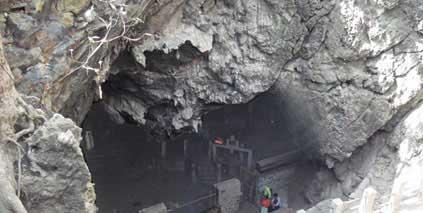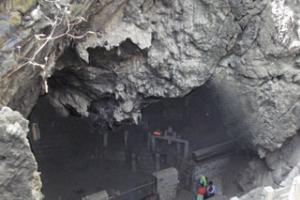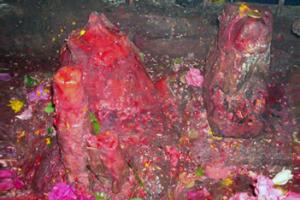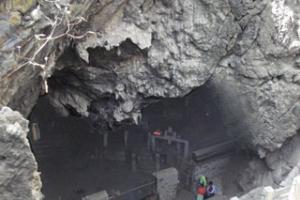Halesi Mahadev Packages

Halesi Mahadev Temple is the most ancient and holiest places of Nepal; it is very popular as The Pashupatinath of the eastern Nepal. It is situated at the hilly region of the country in between the holy rivers Dudh Koshi to the right and Sunkoshi to the left. The temple is situated at the top of a small hill inside a beautiful cave. There lie other numerous small beautiful caves too. Importance Here, the image of the god is inside the cave, which is full of natural beauty. Inside the cave is dark and there are bats flying here and there. It is also a kind of pride for the people living there, as it is as famous as other temples like the Pashupatinath, the Lumbini etc. even internationally. It is the natural cave, which lies in 4th remote hilly region and is believed to be in existence since 6000 years. It is the place full of natural beauty and cultural inheritance. It is popular among the Hindus as well as the Buddhists all over the world.
Mythology
There are three mysterious caves, which are believed to be the three eyes of lord Shiva. As we see in the first cave, we see an image of lord Shiva which is called as Haleshwar Mahadev. In the second cave there is an image of Nandi.
Among these three mysterious caves the first one with the image of lord Shiva is the main part of the temple. After marching down 25 to 30 steps down the stairs at the walls of the cliff there is a big red stone which is worshiped as Gaura Parbata. It is believed to be a joint image of Gauri and Parbati. This cave is in the depth of about 300ft. At the bottom of the cave there is the image of Mahadev made of stone. It is about two and half feet long. One can reach to the end or to the image of the god after walking 102 stairs made of the stones arranged well in the stairs. The stairs are wide enough to walk for a 4/5 people at a time.
It is said that the base of the statue 'Linga' of Mahadev which is nearly two and half feet high up from the ground but the base of the statue leads to the next cave through a small hole. It is called Basaha Gupha. The base of the statue is full of water even under the ground. The main statue of the temple is fenced with the cement pillars it is situated in a square at the middle. Above the statue in the cliff there is an image of cows' udder from which white drops fall on to the statue. It is believed that Kamadhenu (Cow in the heaven who can fulfill the desires wishes if asked) is worshiping the god by offering her milk.
People perform various religious Pujas. (Rudri, Laghu Rudri, Maha Rudri, Aati Rudri) in the temple during different festivals. Some people do such performances to get peace, spiritual happiness and prosperity. The whole temple flutters with the Vedic Mantras at the time of Puja. Those who are poor, have no children and are suffering from sorrow come here and promise to offer something if their wishes and expectation are fulfilled. After their wishes are fulfilled they get back again and offer the god what they have promised to offer. They offer the god one hundred thousand holy threads and leaves of wood apple or by performing prayer and puja.
This is the famous religious destination not only of the district but of the whole Eastern Development Region along with god mahadev there are other god and goddess such as parbati. The cave is full of various entrances and images of different gods. Each and every stone of the cave is full of natural artistic images and the holes in the different corner. An angel stands as attractive doors of the cave. The whole cave is like a big stone which is beautifully carved by the hands of a good artist who worked hard to make it so beautiful. This is one of the most beautiful creations of nature more artistic and pure than the artificial creations. Different images and the different doors in the cave carry their own significance. Among them there are five doors, which are more important than the other doors.
Halesi Mahadev Temple is situated in the Khotang district of eastern Nepal. This is a small hilly area full of natural beauty. The location of the place itself is beautiful. One the other hand, the beautiful and mysterious natural caves; full of different natural images, look as if the stone carving artist have donelt carefully taking a lot of time. Here, the images are all inside the caves which themselves are mysterious.
Ghoptay Dwar: This door is named after its location. Ghoptay Dwar is a Nepali word which means downward facing door. It is located to the Northwest of the image of the god. People enter here from the South and come out of the North. It is about 9 feet long.
Janma Dwar: A little further the Ghoptay Dwar to the east after walking 6 feet sliding way we can get to another door where one is allowed to enter first by putting one leg and the head carefully. It is Janma Dwar which means the birth door
Pap Dwar: To the East-South of the image of the god, there is another door called Pap Dwar. In this door people enter from the east and come out hardly from the West.
Dharma Dwar: After praying the Haleshwar Mahadev when we move forward in the West-North there are two 9/9 feet square shaped stones with a small gap between them. There is a tradition of going in and coming out from that gap. This gap is called Dharma Dwar.
Swarga Dwar: There is another famous door called as Swarga Dwar. Ii looks really amazing if it is viewed from Yagya Shala, close to pap Dwar. People can't reach there, as it is located really in a difficult place where there is no way to get through. It may have been named Swarga Dwar as Swarga in Nepali Means heaven where no people can reach and live in.
There is a legend that people who are really religious can easily enter the four dwars. But those who are not religious they cannot enter any of these dwars.
Worship & Festivals
Lord Vishnu was the first ever devotee to pay homage to the Halesi Mahadev in the Satya Yuga, the golden age where as Balaram did in the third age called Dwapar Yuga. Afterwards, many kings, sages, devotees, philosophers, thinkers, hermits, abbots, ascetics and shankaracharya have been paying homage to this sacred place.
During the homage hours, kettledrum, cymbal, clarinet etc, there is a custom of performing special ceremonial rites of the Halesi Mahadev during some festivals such as Bala Chaturdashi, Shiva Ratri, Ram Nawami and Teez etc. In between, devotees perform various other religious performances like fire sacrifice and recitals of the Rudri, the Chandi and the Vedas, our religious epics, burning of 10 millions holy threads and offering millions of wood apple leaves etc. The Haleshwar Mahadev is taken as the god of fulfilling wishes and giving boons to the real devotees. So devotees vow solemnly and act accordingly as their wishes has been fulfilled. We believe this is only the place for the people all over the world to visit once in a life time and watch the beautiful, mysterious amazing and purely religious place where the people are traditionally rich in their culture. It is really a matter of pride to all of us.
How to go there?
Halesi Mahadev Temple is lies in the Khotang district eastern part of Nepal. There is flight service from Kathmandu to Lamidanda but the flight service are not regular, about 3 times a week to Lamidanda, after Lamidanda there is trekking route to Halesi Mahadev temple, it takes time 5-6 hrs by walk. There is Helipad nearby Halesi Mahadev temple, as same day we can visit Halesi Mahadev temple by private Helicopter, It takes time 2 hrs from Kathmandu to Halesi to Kathmandu.
There is regular bus service from Kathmandu to Katari, There is unpaved way from Katari to Ghurmi, where we can go by jeep or local rented vehicle, After Ghurmi to Halesi there is unpaved road it takes 2-3 hrs by local transport, Also there is trekking route so we can walk after Ghurmi it takes time about 5-6 hrs. And there is another option to go Halesi Mahadev by private Jeep.
Halesi Mahadev Package

Halesi Mahadev Jeep Tour
5 Nights / 6 Days
Halesi Mahadev Tour by Flight
5 Nights / 6 Days



